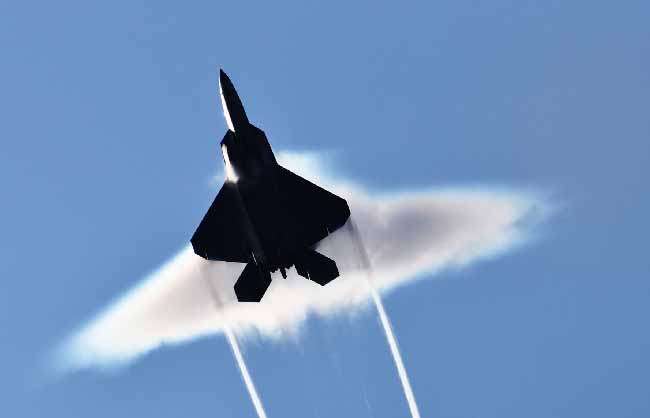What Supersonic Looks Like

The breaking of the sound barrier is not just an audible phenomenon. As a new picture from the U.S. military shows, Mach 1 can be quite visual.
This widely circulated new photo shows an Air Force F-22 Raptor aircraft participating in an exercise in the Gulf of Alaska June 22, 2009 as it executes a supersonic flyby over the flight deck of the aircraft carrier USS John C. Stennis.
The visual phenomenon, which sometimes but not always accompanies the breaking of the sound barrier, has also been seen with nuclear blasts and just after space shuttles launches, too. A vapor cone was photographed as the Apollo 11 moon-landing mission rocketed skyward in 1969.
The phenomenon is not well studied. Scientists refer to it as a vapor cone, shock collar, or shock egg, and it's thought to be created by what's called a Prandtl–Glauert singularity.
Here's what scientists think happens:
A layer of water droplets gets trapped between two high-pressure surfaces of air. In humid conditions, condensation can gather in the trough between two crests of the sound waves produced by the jet. This effect does not necessarily coincide with the breaking of the sound barrier, although it can. To learn more, click here.
The aircraft carrier was participating in Northern Edge 2009, an exercise focused on detecting and tracking things at sea, in the air and on land.
Sign up for the Live Science daily newsletter now
Get the world’s most fascinating discoveries delivered straight to your inbox.
- Gallery: Breaking the Sound Barrier
- The Greatest Explosions Ever
- What is a Sonic Boom?
In The Water Cooler, Imaginova's Editorial Director Robert Roy Britt looks at what people are talking about in the world of science and beyond. Find more in the archives and on Twitter.
Robert is an independent health and science journalist and writer based in Phoenix, Arizona. He is a former editor-in-chief of Live Science with over 20 years of experience as a reporter and editor. He has worked on websites such as Space.com and Tom's Guide, and is a contributor on Medium, covering how we age and how to optimize the mind and body through time. He has a journalism degree from Humboldt State University in California.
Primates: Facts about the group that includes humans, apes, monkeys and other close relatives
'A relationship that could horrify Darwin': Mindy Weisberger on the skin-crawling reality of insect zombification
'Dispiriting and exasperating': The world's super rich are buying up T. rex fossils and it's hampering research











